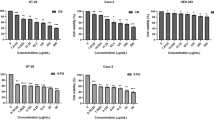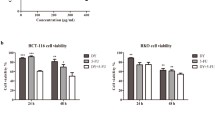Abstract
Purpose
Panax notoginseng is a commonly used Chinese herb. Although a few studies have found that notoginseng shows anti-tumor effects, the effect of this herb on colorectal cancer cells has not been investigated. 5-Fluorouracil (5-FU) is a chemotherapeutic agent for the treatment of colorectal cancer that interferes with the growth of cancer cells. However, this compound has serious side effects at high doses. In this study, using HCT-116 human colorectal cancer cell line, we investigated the possible synergistic anti-cancer effects between notoginseng flower extract (NGF) and 5-FU on colon cancer cells.
Methods
The anti-proliferation activity of these modes of treatment was evaluated by MTS cell proliferation assay. Apoptotic effects were analyzed by using Hoechst 33258 staining and Annexin-V/PI staining assays. The anti-proliferation effects of four major single compounds from NGF, ginsenosides Rb1, Rb3, Rc and Rg3 were also analyzed.
Results
Both 5-FU and NGF inhibited proliferation of HCT-116 cells. With increasing doses of 5-FU, the anti-proliferation effect was slowly increased. The combined usage of 5-FU 5 μM and NGF 0.25 mg/ml, significantly increased the anti-proliferation effect (59.4 ± 3.3%) compared with using the two medicines separately (5-FU 5 μM, 31.1 ± 0.4%; NGF 0.25 mg/ml, 25.3 ± 3.6%). Apoptotic analysis showed that at this concentration, 5-FU did not exert an apoptotic effect, while apoptotic cells induced by NGF were observed, suggesting that the anti-proliferation target(s) of NGF may be different from that of 5-FU, which is known to inhibit thymidilate synthase.
Conclusions
This study demonstrates that NGF can enhance the anti-proliferation effect of 5-FU on HCT-116 human colorectal cancer cells and may decrease the dosage of 5-FU needed for colorectal cancer treatment.





Similar content being viewed by others
References
Aung HH, Mehendale SR, Wang CZ, Xie JT, McEntee E, Yuan CS (2006) Cisplatin’s tumoricidal effect on human breast carcinoma MCF-7 cells was not attenuated by American ginseng (Epub ahead of print). Cancer Chemother Pharmacol
Borek C (2004) Dietary antioxidants and human cancer. Integr Cancer Ther 3:333–341
Cho KH, Kang HS, Jung WS, Park SU, Moon SK (2005) Efficacy and safety of chunghyul-dan (qingwie-dan) in patients with hypercholesterolemia. Am J Chin Med 33:241–248
Christopher R, Dhiman A, Fox J, Gendelman R, Haberitcher T, Kagle D, Spizz G, Khalil IG, Hill C (2004) Data-driven computer simulation of human cancer cell. Ann NY Acad Sci 1020:132–153
Cui XM, Wang CL, Chen ZJ, Wang Y (2002) Estimate of environmental condition on GAP culture of Panax notoginseng. Chin Tradit Herbal Drugs 33:75–77
Dan B, Steven C, Erich S (2004) Chinese herbal medicine: Materia medica, 3rd ed. Seattle, Eastland Press
Delval L, Klastersky J (2002) Optic neuropathy in cancer patients. Report of a case possibly related to 5 fluorouracil toxicity and review of the literature. J Neurooncol 60:165–169
Dong TT, Cui XM, Song ZH, Zhao KJ, Ji ZN, Lo CK, Tsim KW (2003) Chemical assessment of roots of Panax notoginseng in China: regional and seasonal variations in its active constituents. J Agric Food Chem 51:4617–4623
Francois F, Park J, Bini EJ (2006) Colon pathology detected after a positive screening flexible sigmoidoscopy: a prospective study in an ethnically diverse cohort. Am J Gastroenterol 101:823–830
Hawk ET, Levin B (2005) Colorectal cancer prevention. J Clin Oncol 23:378–391
HemaIswarya S, Doble M (2006) Potential synergism of natural products in the treatment of cancer. Phytother Res 20:239–249
Jemal A, Tiwari RC, Murray T, Ghafoor A, Samuels A, Ward E, Feuer EJ, Thun MJ (2004) Cancer statistics, 2004. CA Cancer J Clin 54:8–29
Kaeser MD, Pebernard S, Iggo RD (2004) Regulation of p53 stability and function in HCT116 colon cancer cells. J Biol Chem 279:7598–7605
Konoshima T, Takasaki M, Tokuda H (1999) Anti-carcinogenic activity of the roots of Panax notoginseng. II. Biol Pharm Bull 22:1150–1152
Lam SK, Ng TB (2001) Isolation of a novel thermolabile heterodimeric ribonuclease with antifungal and antiproliferative activities from roots of the sanchi ginseng Panax notoginseng. Biochem Biophys Res Commun 285:419–423
Marsh S (2005) Thymidylate synthase pharmacogenetics. Invest New Drugs 23:533–537
Mehendale S, Aung H, Wang A, Yin JJ, Wang CZ, Xie JT, Yuan CS (2005) American ginseng berry extract and ginsenoside Re attenuate cisplatin-induced kaolin intake in rats. Cancer Chemother Pharmacol 56:63–69
Meregalli M, Martignoni G, Frontini L, Zonato S, Pavia G, Beretta G (1998) Increasing doses of 5-fluorouracil and high-dose folinic acid in the treatment of metastatic colorectal cancer. Tumori 84:662–665
Mohr B, Illmer T (2005) Structural chromosomal aberrations in the colon cancer cell line HCT 116—results of investigations based on spectral karyotyping. Cytogenet Genome Res 108:359–361
Nahleh Z, Tabbara IA (2003) Complementary and alternative medicine in breast cancer patients. Palliat Support Care 1:267–273
Ott MJ (2002) Complementary and alternative therapies in cancer symptom management. Cancer Pract 10:162–166
Pharmacopoeia (2005). Co: Pharmacopoeia of the People’s Republic of China. Chemical Industrial Press, Beijing, vol. 1
Schnell FM (2003) Chemotherapy-induced nausea and vomiting: the importance of acute antiemetic control. Oncologist 8:187–198
Shieh DE, Cheng HY, Yen MH, Chiang LC, Lin CC (2006) Baicalin-induced apoptosis is mediated by Bcl-2-dependent, but not p53-dependent, pathway in human leukemia cell lines. Am J Chin Med 34:245–261
Shinkai K, Akedo H, Mukai M, Imamura F, Isoai A, Kobayashi M, Kitagawa I (1996) Inhibition of in vitro tumor cell invasion by ginsenoside Rg3. Jpn J Cancer Res 87:357–362
Wan JB, Lai CM, Li SP, Lee MY, Kong LY, Wang YT (2006) Simultaneous determination of nine saponins from Panax notoginseng using HPLC and pressurized liquid extraction. J Pharm Biomed Anal 41:274–279
Wang CZ, Basila D, Aung HH, Mehendale SR, Chang WT, McEntee E, Guan X, Yuan CS (2005) Effects of ganoderma lucidum extract on chemotherapy-induced nausea and vomiting in a rat model. Am J Chin Med 33:807–815
Wang CZ, Fishbein A, Aung HH, Mehendale SR, Chang WT, Xie JT, Li J, Yuan CS (2005) Polyphenol contents in grape-seed extracts correlate with antipica effects in cisplatin-treated rats. J Altern Complement Med 11:1059–1065
Wang CZ, Li P, Ding JY, Jin GQ, Yuan CS (2005) Identification of Fritillaria pallidiflora using diagnostic PCR and PCR-RFLP based on nuclear ribosomal DNA internal transcribed spacer sequences. Planta Med 71:384–386
Wang CZ, McEntee E, Wicks S, Wu JA, Yuan CS (2006) Phytochemical and analytical studies of Panax notoginseng (Burk.) FH Chen. J Nat Med 60:97–106
Wong CK, Bao YX, Wong EL, Leung PC, Fung KP, Lam CW (2005) Immunomodulatory activities of Yunzhi and Danshen in post-treatment breast cancer patients. Am J Chin Med 33:381–395
Yoshikawa M (2002) Physiological functions of Panax notoginseng. Shokuhin to Kagaku 44:35–38
Acknowledgments
This work was supported in part by research grants from the American Cancer Society (RSG-05-254–01DDC), the NIH/NCI (1RO1 CA106569-01), and the NIH/NCCAM (AT002176 and AT002445).
Author information
Authors and Affiliations
Corresponding author
Rights and permissions
About this article
Cite this article
Wang, CZ., Luo, X., Zhang, B. et al. Notoginseng enhances anti-cancer effect of 5-fluorouracil on human colorectal cancer cells. Cancer Chemother Pharmacol 60, 69–79 (2007). https://doi.org/10.1007/s00280-006-0350-2
Received:
Accepted:
Published:
Issue Date:
DOI: https://doi.org/10.1007/s00280-006-0350-2




